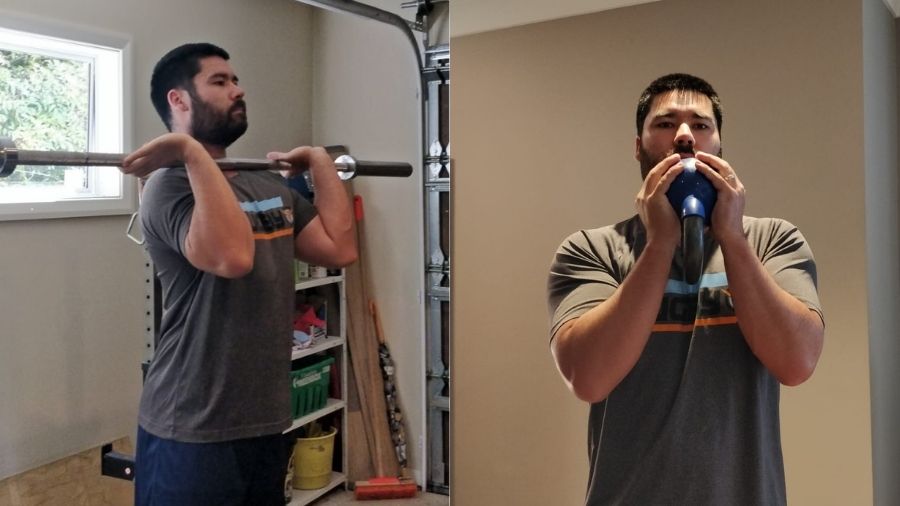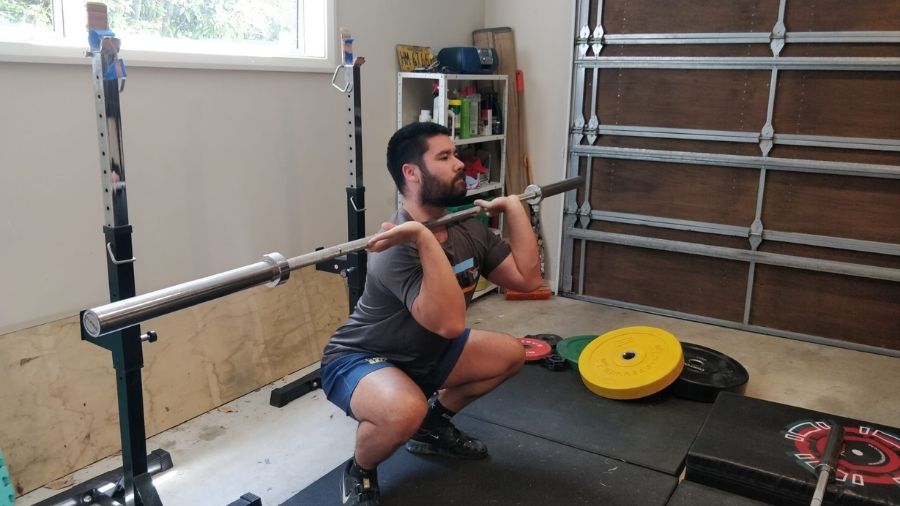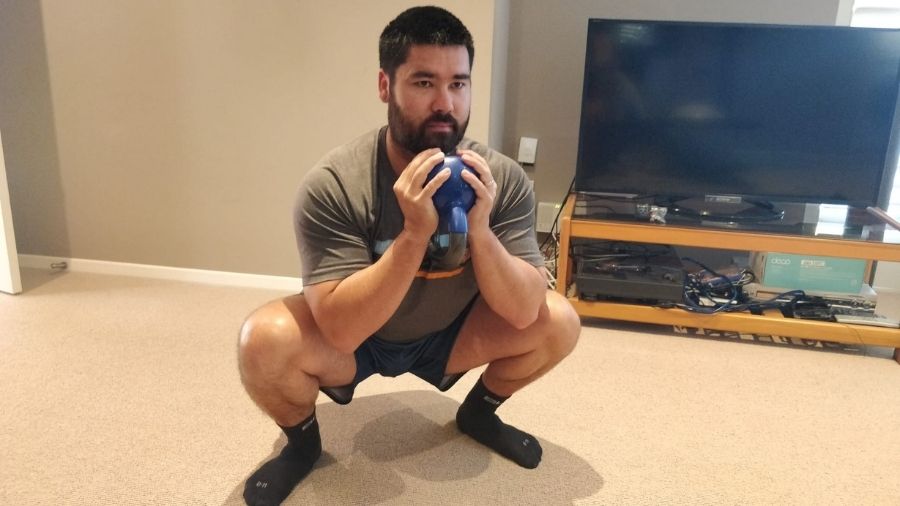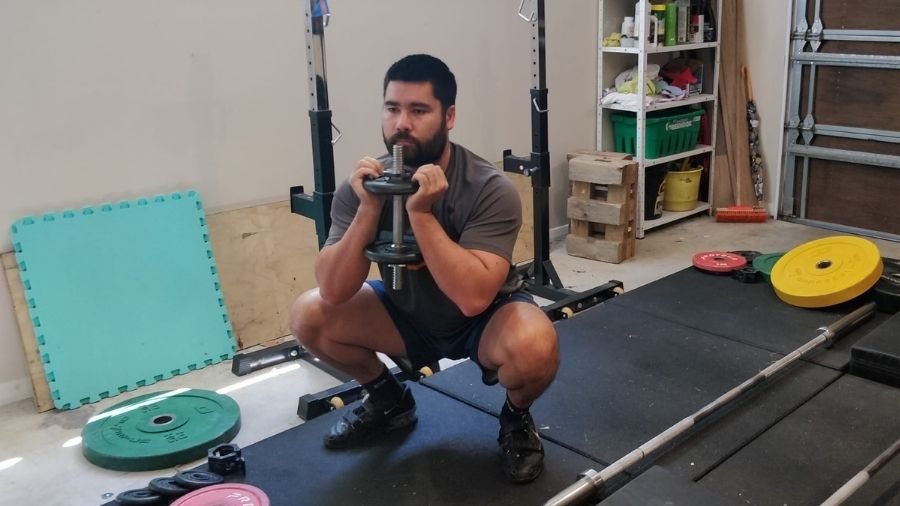Two of the most common squat variations are the goblet squat and the front squat. You’ve probably done both! But is one better than the other?
The front squat is loaded with a barbell on the shoulders in the front rack position. In contrast, the goblet squat is loaded using a dumbbell or kettlebell in the goblet position in front of the chest. Goblet squats are best for beginners to learn to squat, while front squats are great for building strength and mass.
While front squats and goblet squats are squatting exercises, they are not interchangeable within a training program. They give entirely different stimuli, mainly due to the fundamental differences I’ve listed below.
Table of Contents
- Difference Between The Front Squat vs. Goblet Squat
- How To Front Squat
- Common Front Squat Mistakes
- Benefits Of The Front Squat
- How To Goblet Squat
- Common Goblet Squat Mistakes
- Benefits Of The Goblet Squat
- Front Squat vs. Goblet Squat For Quads
- Front Squat vs. Goblet Squat Frequently Asked Questions
- Are Goblet Squats Better Than Front Squats?
- Can You Build Mass With Goblet Squats?
- What Is The Difference Between Goblet Squat And Sumo Squats?
- Why Are Goblet Squats Harder Than Normal Squats?
- How Heavy Should You Goblet Squat?
- Are Goblet Squats Quads Or Glutes?
- Is The Goblet Squat Worth It?
- Is The Goblet Squat A Front Squat?
- Why Is The Front Squat So Hard?
- Will Front Squats Build Mass?
- Summary
Difference Between The Front Squat vs. Goblet Squat
Equipment
While both the front squat and goblet squat are loaded anteriorly (in front of the body), the goblet squat does so by holding a dumbbell or kettlebell while the front squat is loaded with a barbell. The dumbbell or kettlebell is held in the hands like a large goblet. The barbell is loaded on the shoulders in the front rack position for the front squat.
Loading

The front squat allows heavier loads to be used as the weight is supported by the upper back and core in the front rack position. In comparison, the goblet squat supports the load with the arms. The upper back is much stronger than the arms resulting in far heavier loads.
That means more stress can be placed on the muscles of the legs when front squatting compared to goblet squats. However, there are strategies to continually load the goblet squat heavier even when your arms can no longer support heavier dumbbells or kettlebells.
One strategy is to wear a weighted vest. Another method is to drape large chains around your neck, which looks more hardcore.
Mobility
Both the front squat and goblet squat have similar lower body mobility requirements. Ankle and hip mobility are of utmost importance to getting into a deep squat position. However, the front squat requires serious mobility from the upper body, unlike the goblet squat.
Many lifters struggle with their front rack mobility when supporting the barbell on their shoulders in the clean grip. It requires solid shoulder external rotation, triceps length, and wrist mobility. You can solve this by using a cross grip.
But the other mobility issue that arises when front squatting is thoracic mobility. Lifters who have a kyphotic posture or struggle to extend their thoracic spine will struggle to keep the barbell in the rack position when descending in the squat.
The goblet squat has more freedom with upper-body mobility, and having a slight forward lean isn’t going to make or break the exercise.
Best Suited For
The goblet squat is best suited for those learning to squat or have limited equipment at home. It is the first exercise taught to beginners to teach the squat movement pattern. In my experience, it is easier to teach a goblet squat holding a weight than it is to learn a bodyweight squat.
Holding the weight at chest height creates a counterbalance, so getting into a deep squat position is more manageable. The front squat is best suited for those looking to drastically improve full-body strength, build their quads and glutes, or those seeking athletic performance benefits.
For those that compete in Olympic Weightlifting or Powerlifting, you will front squat as an accessory exercise to the clean & jerk and the squat.
Muscles Worked
Both goblet and front squat target similar muscle groups as both are squat movement patterns. These are the quadriceps, glutes, and erector spinae [1]. The hamstrings and calves are activated to some extent but do not take the brunt of the work and won’t increase significantly in muscle size.
The goblet squat will also work the shoulders and arms muscles isometrically as you support the load in your hands.
How To Front Squat
Here is a step-by-step covering how to front squat effectively.
- Set up the bar in the front rack position using either the clean or cross grip. This will depend on your mobility and if you are a competitive Weightlifter.
- Unrack the barbell and take one step back with each foot. Point your toes slightly out. They should not be pointing straight ahead.
- Keep the elbows as high as possible as you start to descend. Your bodyweight should be through the middle of your feet.
- Break at the hips and knees simultaneously while spreading your knees out, so they track over your middle toes.
- Descend until your hamstrings are against your calves. This will be below a parallel position, and your knees will be past your toes. Your torso will be upright with your elbows high.
- Drive through the legs while keeping an upright torso and elbows high.
Common Front Squat Mistakes
While the squat looks like a relatively easy movement, there are many common mistakes made by beginner to experienced lifters.
Sitting Back Instead Of Down
The way the squat is typically taught is wrong. “Squat like you’re sitting onto a chair” or “sit back” are all wrong and will force you to break at the hips and not let your knees be pushed forward. Your torso will lean forward, and you will lose the bar from the front rack position.
These cues came from geared powerlifting as they needed to sit back into their squat suits to get the maximum rebound from the elastic suit. For the raw lifter (i.e., no special suits), you need to sit down, not just back.
Letting The Elbows Drop
The back follows the elbows. If the elbows start to drop, the upper back will also start to round. This will make your front squat infinitely harder, and if they fall too much, you may have to dump the barbell leading to a failed lift.
Not Letting The Knees Go Past The Toes
This old myth still does the rounds. It was thought that letting the knees go past the toes would cause knee problems. However, this is not true. While it does allow you to place greater stress on the quads, it doesn’t lead to a knee injury. Especially since front squatting results in less compressive forces on the knee [1].
Benefits Of The Front Squat

Greater Quad Activation
Because of the upright torso position, the knees are pushed further forward (especially compared to the back squat), which elicits greater activation of the quads [2]. Generally, the front squat is used to overload the quads.
Better Weightlifting Performance
There’s a reason Olympic Weightlifters perform the front squat. One such reason is how well it correlates to the Olympic lifts. For example, the hang power clean positively correlates with front squat 1RM [3]. Meaning the more you can front squat, the more you are likely to hang power clean.
Similar Athletic Performance Enhancements To Back Squats
The front squat can improve vertical jump with no differences compared to back squats [4]. Further, athletes with a larger front squat 1RM display faster sprint times and higher power outputs when jumping [3].
How To Goblet Squat
Here is a step-by-step covering how to goblet squat effectively.
- Pick up a dumbbell and support the head in the palms of your hands. The dumbbell handle should hang vertically. If you are using a kettlebell, turn it upside down and support the bell in your palms. Your fingers should be pointing up.
- Keep your elbows tight under the dumbbell or kettlebell.
- Place your feet just outside shoulder width and point your toes slightly out.
- Squat down by breaking at the hips and knees simultaneously while keeping an upright torso.
- You must tuck the elbows in as they will go between your legs.
- Once the hamstrings are against your calves, drive with your legs back to the top.
Common Goblet Squat Mistakes
Not Tucking The Elbows
If you don’t tuck the elbows, you will find they hit your legs once you squat deep enough. This is a problem as it will limit your depth. Tuck your elbows to keep them out of the way.
Half Squatting
The goal of the goblet squat is to sit into a full squat. It is a teaching tool to get full depth. By stopping the squat halfway, you miss all the mobility and strength benefits that will carry over to barbell squatting.
Benefits Of The Goblet Squat

A Great Teaching Tool For The Squat
The goblet squat is the first exercise a beginner will learn before embarking on the front or back squat. It can be performed with a light dumbbell or kettlebell and is less intimidating to the first-time lifter.
Reduced Mobility Requirements
The mobility requirements are reduced because you don’t need to get into the front rack position. Not just from the shoulders and wrists but also the thoracic spine.
Easy To Fail
The goblet position makes it very easy to fail a lift if it happens. Dropping the weight when sitting in the deep squat is only a short drop to the floor. The front squat can also be dumped easily, but it can be daunting for beginners to do that.
Less Equipment Needed
You can easily perform the goblet squat at home with limited equipment. If you have a dumbbell or kettlebell, you can goblet squat. You need a power rack or squat stand, a barbell, and plates for the front squat.
Front Squat vs. Goblet Squat For Quads
The front squat is a better option for building big quads than the goblet squat. Purely because you can load it much heavier, leading to greater mechanical tension on the quads. However, the goblet squat can be an alternative for those who suffer from bad knees.
Front Squat vs. Goblet Squat Frequently Asked Questions

Are Goblet Squats Better Than Front Squats?
Goblet squats are not better than front squats. They are just another squat variation. Where goblet squats shine is being a teaching tool. It is much less complex than the front squat making it perfect for beginners.
Can You Build Mass With Goblet Squats?
You can build muscle mass with goblet squats, but at some point, the strength of your legs will surpass the strength of your arms and shoulders, and you will not be able to use enough load to stimulate new muscle growth.
What Is The Difference Between Goblet Squat And Sumo Squats?
The only difference between a goblet squat and a sumo squat is the stance width. A sumo squat involves a wide stance that will put an immense stretch on your adductor muscles. You can load this with the goblet position too.
Why Are Goblet Squats Harder Than Normal Squats?
Goblet squats only become harder than regular squats when the loads are too heavy to hold in your hands. Getting the dumbbell or kettlebell into position takes a lot of effort, and keeping it there is just as tricky. Unfortunately, the load is still too light to tax your legs effectively.
How Heavy Should You Goblet Squat?
How heavy you goblet squat will depend on how strong you are. Rank beginners can start between 6-10 kgs. As you get stronger, there is no limit to how heavy you should goblet squat. It will also depend on how heavy your dumbbells go.
Are Goblet Squats Quads Or Glutes?
Goblet squats target both your quads and glutes. Like other forms of squats, the quads and glutes are the primary targeted muscles.
Is The Goblet Squat Worth It?
The goblet squat is worth it for beginners learning to squat. It will teach the basics of the squat with a counterbalanced weight making it easier to reach full depth. For intermediate to advanced lifters, the goblet squat is not worth it for developing strength and muscle size as you cannot load it heavy enough.
Is The Goblet Squat A Front Squat?
The goblet squat is not a front squat as the weight is not racked on the shoulders. While the weight is in front of your body, it is in the goblet position, not the front rack. The front squat specifically refers to having a barbell on your shoulders.
Why Is The Front Squat So Hard?
The front squat is so hard because it’s not easily supported on your traps. When it is on your traps, it is directly on your spine. The barbell on your shoulders forces your upper back and core to support the load as it is in front of your spine.
Will Front Squats Build Mass?
Front squats will build muscle mass on your quads and glutes. It is an excellent choice if you are targeting your quads in particular. It can be challenging to perform for high reps due to the extra support needed from your upper back. Instead of your legs fatiguing first, it will be your posture.
Summary
The front squat and goblet squat serve their distinct purposes. After the beginner stage of learning the squat, the goblet squat almost becomes obsolete for the lifter looking to pack on mass and build immense strength. Once you’ve learned the front squat, you’re on your way to building huge thighs and a rock-solid upper back and core.
References
1. Gullett, J. C., Tillman, M. D., Gutierrez, G. M., & Chow, J. W. (2009). A biomechanical comparison of back and front squats in healthy trained individuals. The Journal of Strength & Conditioning Research, 23(1), 284-292.
2. Yavuz, H. U., Erdağ, D., Amca, A. M., & Aritan, S. (2015). Kinematic and EMG activities during front and back squat variations in maximum loads. Journal of sports sciences, 33(10), 1058-1066.
3. Hori, N., Newton, R. U., Andrews, W. A., Kawamori, N., McGuigan, M. R., & Nosaka, K. (2008). Does performance of hang power clean differentiate performance of jumping, sprinting, and changing of direction?. The Journal of Strength & Conditioning Research, 22(2), 412-418.
4. Peeni, M. H. (2007). The effects of the front squat and back squat on vertical jump and lower body power index of Division 1 male volleyball players. Brigham Young University.
